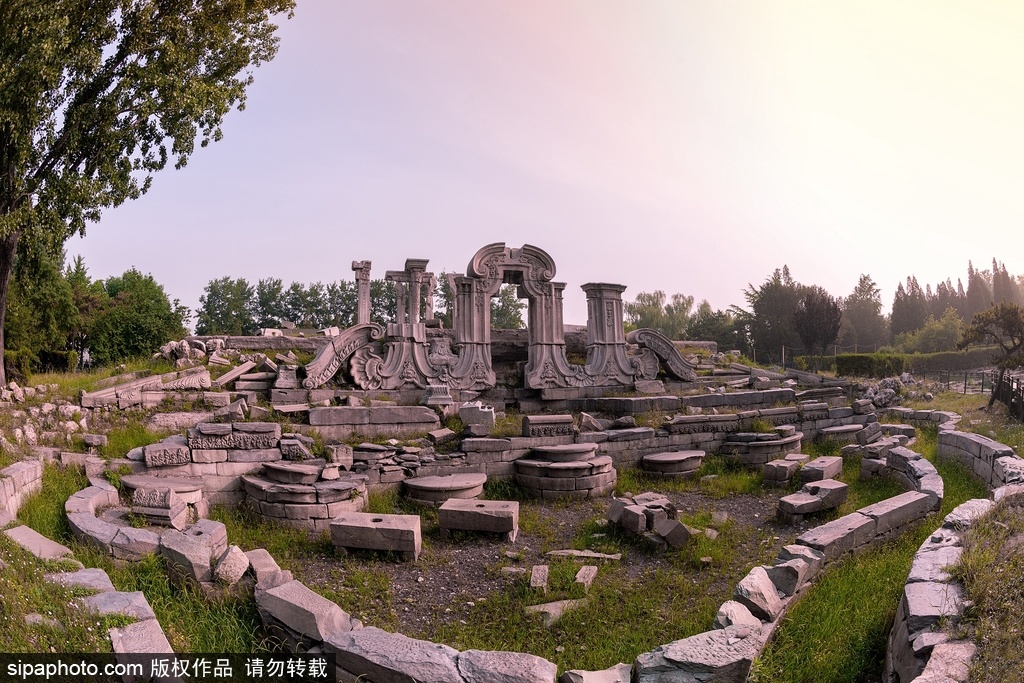
Rating:AAAA
Key Words:Theme Park, Landscape, Royal gardens
Description:
The old summer palace, also called Yuanmingyuan, is the garden for 4 emperors: Yongzheng, Qianlong, Jiaqing, Daoguang and Xianfeng. After 150 years designation, the garden became the most grand and most well-known garden in Chinese history.
The Old Summer Palace enjoyed a good reputation all over the world with its large regional scale, outstanding construction techniques, splendid building complexes, rich cultural collections and profound national culture connotations. The garden inherited the tradition of Chinese royal gardens of more than 3,000 years of history. It featured elegance and luxury of royal architectures, and the gentleness and gorgeousness of gardens in the south of the lower reaches of the Yangtze River. In the meantime, it also learned from the style of European gardens. The overall layout was harmonious and perfect, symbolizing the high level of construction techniques of Chinese ancient gardens.
The Old Summer Palace was a gift for Emperor Kangxi’s fourth son, Yongzheng. At that time, it was outclassed by Changchun Garden. After Yongzheng ascended the throne, he greatly expanded the imperial garden. Unfortunately, owing to the war during the end of the Qing Dynasty, we cannot witness its glory with our eyes, but it can be learned from the literature.
The Imperial Gardens at the Old Summer Palace were made up of three gardens:
1.Garden of Perfect Brightness (圆明园;圓明園;Yuánmíng Yuán)
2.Garden of Eternal Spring (长春园;長春園;Chángchūn Yuán)
3.Garden of Elegant Spring (绮春园;綺春園;Qǐchūn Yuán)
Together, they covered an area of 3.5 square kilometres (860 acres), almost five times the size of the Forbidden City grounds and eight times the size of the Vatican City. Hundreds of structures, such as halls, pavilions, temples, galleries, gardens, lakes and bridges, stood on the grounds.
In addition, hundreds of examples of Chinese artwork and antiquities were stored in the halls, along with unique copies of literary works and compilations. Several famous landscapes of southern China had been reproduced in the Imperial Gardens.

History
Yuanmingyuan is located in Haidian District, the western suburb of Beijing, and is adjacent with Summer Palace. Firstly built in the 46th year during Emperor Kangxi's reign (1707), Yuanmingyuan is composed of three gardens: Yuanmingyuan, Changchunyuan and Qichunyuan. With the floor area of 350 hectares and building area of almost 200,000 square meters, Yuanmingyuan was a vast royal palatial garden established and operated for over 150 years by emperors in Qing Dynasty. Yuanmingyuan enjoys worldwide reputation for its grand land scale, outstanding construction skills, elegant architectural landscape, rich cultural collections as well as extensive and profound national culture implication, and is renowned as the “model of all garden construction arts” and the “Garden of Gardens”. In October 1860, the Anglo-French forces sacked and looted Yuanmingyuan and burned it to the ground.
In November 1976, the Administrative Office of Yuanmingyuan was established. In January 1988, Yuanmingyuan Park was announced as a key cultural relic protection site at the national level. On June 29, 1988, Yuanmingyuan Park was officially opened to the public. After requisition of land for two times in 1990 and 1993, Yuanmingyuan Park recovered all its land use right, with the land size equal to the size during the flouring period of Yuanmingyuan. In September 1996, Yuanmingyuan was named as a National Patriotism Education Base by six ministries and commissions. In November 1998, Yuanmingyuan Park was named as the Beijing National Defense Education Base by Beijing National Defense Education Commission. In September 2000, The Plan for Yuanmingyuan Park was officially approved by the State Administration of Cultural Heritage. On November 20, 2008, Yuanmingyuan Park was awarded as one of the “Top 16 New Sceneries of Beijing”, and became one of the 16 charming new business cards which represented Beijing.
Destruction
In 1860, during the Second Opium War, British and French expeditionary forces, having marched inland from the coast at Tianjin (Tientsin), arrived inBeijing (Peking). In mid-September, two envoys, Henry Loch and Harry Parkes went ahead of the main force under a flag of truce to negotiate with Prince Yi and representatives of the Qing Empire at Tongzhou (Tungchow). After a day of talks, they and their small escort of British and Indian troopers (including two British envoys and Thomas William Bowlby, a journalist for The Times) were taken prisoner by the Qing general Sengge Rinchen. They were taken to the Ministry of Justice (or Board of Punishments) in Beijing, where they were confined and tortured. Parkes and Loch were returned after two weeks, with 14 other survivors. 20 British, French and Indian captives died. Their bodies were barely recognizable.
On the night of 5 October, French units diverted from the main attack force towards the Old Summer Palace. At the time, the palace was occupied by only some eunuchs and palace maids; the Xianfeng Emperor and his entourage had already fled to the Chengde Mountain Resort in Hebei. Although the French commander Charles Cousin-Montauban assured his British counterpart, James Hope Grant, that "nothing had been touched", there was extensive looting by French and British soldiers. There was no significant resistance to the looting, even though many Qing soldiers were in the vicinity. On October 18, Lord Elgin, the British High Commissioner to China, retaliated against the Chinese resistance by ordering the destruction of the Old Summer Palace. Destroying the Old Summer Palace was also thought to be a way of discouraging the Qing Empire from using kidnapping as a means of resisting British invasion. It took 3,500 British troops to set the entire place ablaze, and the massive fire lasted for three days. Unknown to the troops, some 300 remaining eunuchs and palace maids, who concealed themselves from the intruders in locked rooms, perished with the burnt palace buildings. Only 13 buildings survived intact, most of them in the remote areas or by the lakeside. (The palace would be sacked once again and completely destroyed in 1900 when the forces of the Eight-Nation Alliance invaded Beijing. Charles George Gordon, who was then a 27-year-old captain in the Royal Engineers and part of the 1860 Anglo-French expeditionary force, wrote about his experience:
“We went out, and, after pillaging it, burned the whole place, destroying in a vandal-like manner most valuable property which [could] not be replaced for four millions. We got upward of £48 apiece prize money ... I have done well. The [local] people are very civil, but I think the grandees hate us, as they must after what we did the Palace. You can scarcely imagine the beauty and magnificence of the places we burnt. It made one's heart sore to burn them; in fact, these places were so large, and we were so pressed for time, that we could not plunder them carefully. Quantities of gold ornaments were burnt, considered as brass. It was wretchedly demoralising work for an army.”
British and French looters preferred porcelain (much of which still graces British and French country houses while neglecting bronze vessels prized locally for cooking and burial in tombs. Many such treasures dated back to the Shang, Zhou and Han dynasties and were up to 3,600 years old. A specific exception was the looting of the Haiyantang Zodiac fountain with its twelve bronze animal heads. Some of the most notable treasures ended up at the Chinese Museum in the Palace of Fontainebleau, which Empress Eugénie specifically set up in 1867 to house these newly acquired collections. Once the Old Summer Palace had been reduced a sign was raised by the invaders with an inscription in Chinese stating, "This is the reward for perfidy and cruelty". The burning of the palace was the last act of the war.
According to Professor Wang Daocheng of the Renmin University of China, not all of the palace was destroyed in the original burning. Instead, some historical records indicate that 16 of the garden scenes survived the destruction in 1860. Wang identifies the Republican era and the Cultural Revolution as two significant periods that contributed further to the destruction of the Old Summer Palace. Photographic evidence and eye witness accounts make it clear that (although the palace complex was initially protected by the Qing emperors) it was during the Boxer Rebellion and in the immediate aftermath of the fall of the dynasty when most of the surviving structures were destroyed. Further, the Imperial household itself sold off the magnificent trees in the garden for revenue during the 1890s and after 1900 the palace was used as a veritable builder's yard for anyone who wanted construction materials. Entire buildings were built of materials taken from the Yuanming Yuan and smart Peking houses were adorned with sculptures and architectural elements plundered from the site.
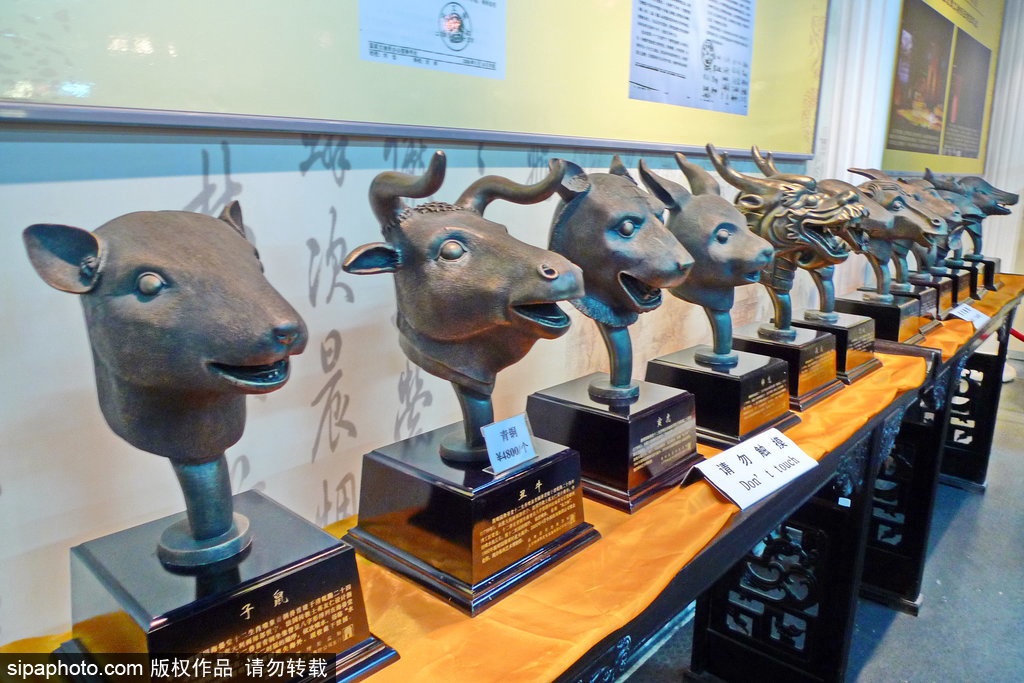
Like the Forbidden City, no commoner had ever been allowed into the Old Summer Palace, as it was used exclusively by the imperial family of the Qing Empire. The burning of the Old Summer Palace is still a very sensitive issue in China today. The destruction of the palace has been perceived as barbaric and criminal by many Chinese, as well as by external observers. In his"Expédition de Chine", Victor Hugo described the looting as, "Two robbers breaking into a museum. One has looted, the other has burnt. ... one of the two conquerors filled its pockets, seing that, the other filled its safes; and they came back to Europe laughing hand-in-hand. ... Before history, one of the bandits will be called France and the other England." In his letter, Hugo hoped that one day France would feel guilty and return what it had plundered from China.
Mauricio Percara, journalist and Argentine writer who works at China Radio International, talks about the apology through the literature by Victor Hugo and mentioned in his story entitled redemption the bust of the French writer located in the old Summer Palace: "at the site where their French peers ever posed his destructive feet today a radiant bust of the great Victor Hugo rises. From the old Summer Palace, the gardens of perfect brightness, a righteous French poses her look of stone in the snow falling obediently on the worn floor of the capital of the North."
Recent developments and plans
There are currently several plans in China for rebuilding the Imperial Gardens, but such moves have been opposed on the grounds that they will destroy an important relic of modern Chinese history. In addition, any rebuilding would be a colossal undertaking, and no rebuilding of above-the-ground structures has been approved. However, the lakes and waterways in the eastern half of the gardens have been dug up again and refilled with water, while hills around the lakes have been cleared of brushwood, recreating long-forgotten vistas. Several temples located inside the Old Summer Palace grounds have also been refurbished and rebuilt.
In February 2005, work was undertaken to reduce water loss from the lakes and canals in the Old Summer Palace by covering a total of 1.33 square kilometres of the beds with a membrane to reduce seepage. The park administration argued the prevention of water loss saves the park money, since water would have to be added to the lakes only once per year instead of three times. However, opponents of the project, such as Professor Zhengchun Zhang of Lanzhou University, feared the measure will destroy the ecology of the park, which depends on the water seepage from the lakes and the connection between the lakes and the underground water system. It is also feared the reduced seepage from the lakes will disturb Beijing's underground water system which is already suffering from depletion. There are also concerns about the gardens, which is a designated heritage site in the city of Beijing, changing their natural appearance. This issue, when brought up with the general public several weeks later, immediately caused an uproar from the press and became one of the hottest debates on the Internet in China due to the still painful memory of foreign humiliation epitomised in the destruction of the Old Summer Palace. The Beijing Environmental Protection Bureau (BEPB) recently conducted an assessment of the environmental impact of the measure.
A partial copy of the palace, the "New Yuanming Gardens" (圆明新园;圓明新園), was built in 1997 in the southern city of Zhuhai in Guangdong province, as an amusement park of 1.39 km², including an 80,000 m² lake.
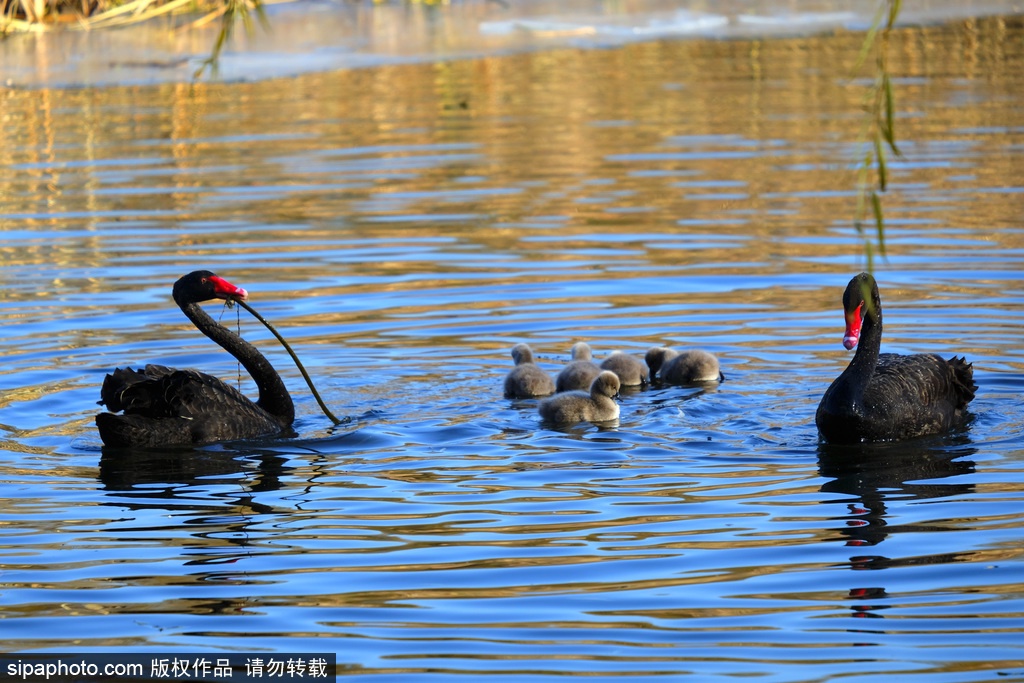
Up to the present, many relics which were taken from the Old Summer Palace remain in foreign museums and private collections. Although the Chinese government has tried to recover them, only a few statuettes from the Garden of Eternal Spring have actually been returned. Seven of the 21 columns displayed at the KODE Art Museums in Bergen, Norway were returned to Peking University in 2014 as part of a deal set up by alumnus Huang Nubo, a real estate developer who donated 10 million Norwegian kroner (US$1.6 million) to the museum, according to theChina Daily. It is still debated in China whether to apply for an inclusion of the Old Summer Palace on the list of UNESCO World Heritage Sites. The ruins of the Old Summer Palace remain open to the public and are an important tourist attraction in Haidian District. They can be accessed from Yuanmingyuan Park station on Line 4 of the Beijing Subway.

Admission Ticket Prices
The ticket offices are in the Palace Gate of Qichunyuan , the East Gate of Changchunyuan , the Two Place Gates and Gate of Zaoyuan.
Admission Ticket for the Main Entrance
Admission Ticket for Adults: RMB 10 yuan per person time
Half-price Admission Ticket: RMB 5 yuan per person time
Monthly Admission Ticket: RMB 15 yuan per month per person [From the first day to the fifth day of each month, the monthly admission ticket can be bought in the ticket offices outside the Palace Gate of Yichunyuan and the East Gate, with the applicant’s photo; RMB 0.5 yuan, the cost of production for the monthly admission ticket, should also be charged. ]
Site of European Palaces Scenic Zone (including Dashuifa, the Exhibition Hall and the Labyrinth)
Admission Ticket for Adults: RMB 15 yuan per person time
Half-price Admission Ticket: RMB 5 yuan per person time
Model Exhibition of Yuanmingyuan during its Flourishing Period
Admission Ticket for Adults: RMB 10 yuan per person time
Pass Ticket
Admission Ticket for Adults: RMB 25 yuan per person time
Half-price Admission Ticket: RMB 10 yuan per person time
Contact Telephone: 010-82670330;62543673
Opening Hours of Yuanmingyuan Park
From May to August 7:00──19:00
April, September and October 7:00──18:00
From January to March and from November to December 7:00──17:30
Major scenic spot
Curving Courtyard and Lotus Pond
Located between Rear Lake and Fuhai Lake, Curving Courtyard and Lotus Pond is one of the 40 sceneries of Yuanmingyuan. It imitates from the landscape in Xihu Lake of Huangzhou with the same name.
The pond area was vast and green waves were like mirror. In summer, it was comfortable to sit quietly in Quyuan Corridor and appreciated the scenery of thousands of stems swaying in green water.
The Universal Peace
Located in the west side of Rear Lake and close to Apricot-Flower Villa in the east, the Universal Peace is one of the 40 sceneries of Yuanmingyuan (Shan’gao Shuichang is outside of the lake in the southwest). It was the scenery garden with the main architecture of 卍 Pavilion. It was built in the early years of Yongzheng’s reign.
Emperors Yongzheng was especially fond of staying here. It was one of resting palaces for Emperor Qianlong for strolling about. Emperor Qianlong regularly served the empress dowager to have dinner here during Dragon Boat Festival.
Eternal Spring Fairy Hall

Located to the west of Main Audience Hall and the south of Harmony of the Present with the Past, Eternal Spring Fairy Hall is one of the 40 sceneries of Yuanmingyuan. This scenic spot is near the garden wall in the south, and is surrounded by waters and mountains. It is the architecture groups with the feature of garden within gardens.
Shan’gao Shuichang
Located in the southwest corner of Yuanmingyuan and built in the early years of Yongzheng’s reign, Shan’gao Shuichang is one of the 40 sceneries of Yuanmingyuan.
Shan’gao Shuichang was the place for emperors of Qing Dynasty to entertain people from vassal states and a place to hold royal fireworks during Lantern Festival. It is also a place for emperors to entertain emissaries from the regions outside of Beijing.
Harmony of the Present with the Past
Located to the north of the Magnanimous World and built around the 4th Year of Qianlong’s reign (1739), Harmony of the Present with the Past is one of the 40 sceneries of Yuanmingyuan. As the architecture scenery, it was also a place for emperors in Qing Dynasty to discuss affairs from the past to present and conduct literary pursuits.
Xiyang Lou
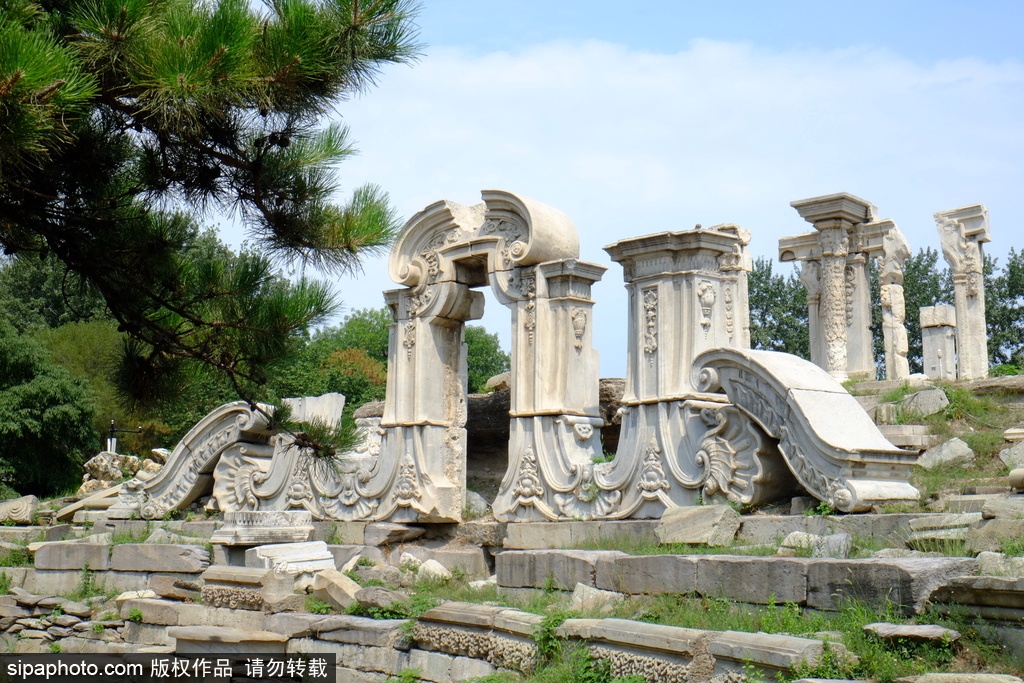
Xiyang Lou(Chinese:西洋楼;pinyin:Xīyáng Lóu;lit.: 'Western mansion(s)'), are ruins of 18th-century European-style imperial buildings on the grounds of the Old Summer Palace in Beijing, China. They are located in the northern part of the Changchun Yuan (Garden of Eternal Spring), one of the three gardens which once made up the Old Summer Palace, and cover an area of about 7 hectares.
The Xiyang Lou were commissioned by the Qianlong Emperor and designed mainly by the Italian Jesuit Giuseppe Castiglione who was in his service as a court painter. Castiglione relied on the French Jesuit scientist Michel Benoist for the engineering tasks, in particular for the fountains, which were the chief interest of the emperor. Construction was carried out by Chinese craftsmen working under their supervision with some further contributions by other European artists, such as the German Ignaz Sichelbarth and the Florentine Bonaventura Moggi. Planning of the gardens started in 1747 and four years later in 1751, the first waterworks (Xieqiqu) were completed. Other milestones were the building of a large labyrinth (Huanghuazhen) in the years 1756 to 1759 and an observatory (Yuanying Guan) which was added in 1783.
Like the rest of the Old Summer Palace, the Xiyang Lou was destroyed in a fire laid by the Anglo-French allied forces in 1860 during the Second Opium War in response to the imprisonment and torture of their peace delegation by the Chinese. However, since the masonry work was not consumed by the fire, significant ruins of many of the buildings can still be found on the site. Some conservation work on the site was carried out between 1977 and 1992. The Huanghuazhen labyrinth was rebuilt during this time.
Haiyantang
The Haiyantang (Chinese:海晏堂; pinyin: Hǎiyàntáng) was an area in the Xiyang Lou(Western style mansions) of the Old Summer Palace, which included the famous Zodiac Fountain-water clock fountain consisting of 12 bronze Chinese zodiac statues. Supposedly designed by Giuseppe Castiglione for the Qianlong Emperor, the statues would spout out water from their mouths to tell the time. The bronze-cast heads of the stone statues were among the treasures looted during the destruction of the Old Summer Palace by British and French expeditionary forces in 1860 during the Second Opium War. Since then, they have been among the most visible examples of attempts to repatriate Chinese art and cultural artifacts. About the scandal with two of this heads see 2009 auction of Old Summer Palace bronze heads.
Exquisite Jade Rock Palace
Locate to the east side of Tripataka Hall and basically completed in the 12th Year of Qianlong’s reign (1747), Exquisite Jade Rock Palace is a scenic garden with lake around. During the flouring time, the plant in Exquisite Jade Rock Islet was mainly pines and bamboos.
Haiyue Kaijin
Located in the lake center to the north of Siyong Room and completed in the 12th Year of Qianlong’s reign (1747), the architecture of Haiyue Kaijin is dignified and resplendent, which is like mirage. It is a good place for emperors of Qing Dynasty to climb up high and look far into the distance.
Tripataka Hall
Located in the center of Chuangchunyuan and basically completed in the 12th Year of Qianlong’s reign (1747), Tripataka Hall is the largest architecture group in Changchunyuan. It is generally called Chunhua Pavilion later.
Tripataka Hall is one of the resting palaces for emperors in Qing Dynasty. Emperor Qianlong came here after the Lantern Festival, interviewed leaders of nationalities and held banquets for envoys from foreign countries.
Danhuai Hall
Located in the primary palace gate of Changchunyuan, Danhuai Hall is the main hall of Changchunyuan. This scenery is the palace gate zone of Changchunyuan.
Changchunyuan palace hall gate was completed in the 12th Year of Qianlong’s reign (1747), which was dedicated for the emperor. In the flouring period, this gate ranked the second to the grand palace gate of Yuanmingyuan. The two gates are known as the two palace gates.
Danhuan Hall is also called the Hall of Diligent Government, which was used as the place for entertaining people from vassal states.
Hill of Perspective
Hill of Perspective is located to the east of Dashuifa. Xianfa means focus perspective, a painting method originated from the west. Hill of Perspective is composed of round hill, western style pavilion as well as eastern and western decorated archways under the hill. Hill of Perspective was also known as the "Horse-Riding Platform," since Emperor Qianlong used to ride his horse here.
Throne for Viewing the Waterworks
Located to the opposite of Dashuifa, Throne for Viewing the Waterworks is the place for emperors of Qing Dynasty to appreciate the fountains of Dashuifa.
After the disaster of Yuanmingyuan, it has experienced vicissitude of more than 100 years. The surviving carved pillars and stone shrine and screen of Immense Ocean Observatory and Dashuifa still stand in the original place lonely, which become the image of Yuanmingyuan in people’s mind.
Dashuifa

Completed around the 24th Year of Qianlong’s reign (1759), Dashuifa is garden scenery with the main part fountain. The fountain is also the largest in European Palaces Scenic Zone. The main architecture is large stone shrine-shaped structure, in the middle there is a lion head spraying, along with seven-level water discs to form waterfall. In the front, an oval fountain is underneath with the shape of a chrysanthemum. There is a male sika deer in the pond, with the antler divided into water sprays of 8 bifurcations. There are hunting dogs which are running around the sika deer. The mouths of these hunting dogs spray water, and the water shoots to the body of the sika deer with a splash. Two roll-tailed bronze beasts similar to dogs in the east end and the west ends are chasing the sika deer, which is known as “hunting dogs chasing the sika deer”, and called by “the war of the beasts” the westerners.
Immense Ocean Observatory
Located in the north end of the axle wire of Changchunyuan and close to Dashuifa in the south, Immense Ocean Observatory is a European style bell tower palace hall. It was an additional architecture completed in the 48th Year of Qianlong’s reign (1783).
Belvedere
Located to the east of Aviary, Belvedere was completed in the 24th Year of Qianlong’s reign (1759). Belvedere is two-floor western style small buildings, which was a mosque for the worship of Rong Fei (Fragrant Concubine), a Uygur concubine of Emperor Qianlong.
Hall of National Peace
Located to the east of Belvedere and basically completed in the 24th Year of Qianlong’s reign, Hall of National Peace is the largest garden scenery of European Palaces Scenic Zone. The main building of Hall of National Peace faces the west. Dozens of arc-shaped stone steps embrace the fountain downstairs. In the west of the pond, a stone carved shell with the decoration of foreign flowers stands high. On the V-shaped platform around the pond stand 12 bronze statues with animal heads and human bodies, the animals being those representing the 12 earthly branches. In every two hours, water is sprayed out successively from each animal's mouth. In the noon, the 12 animal heads spray water together. People can estimate time by looking at which animal is spraying. Thus the fountain is also called the "Water Clock."
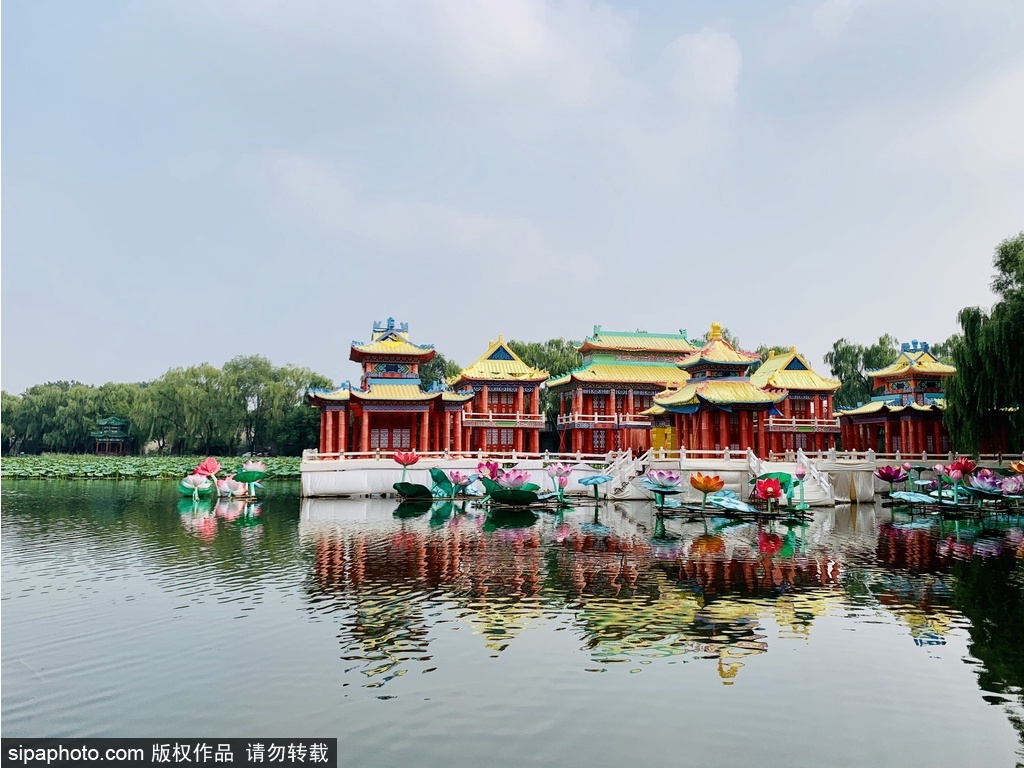
Harmonious Wonder
Located in the south of the west end of European Palaces Scenic Zone and completed in the in the 16th Year of Qianlong’s reign (1751), Harmonious Wonder is the first European architecture in European Palaces Scenic Zone, and a place for performance of Chinese and western music. To the south of the main building, there is a large fountain in the shape of a flowering Chinese crabapple, with bronze swallows, bronze sheep and Western-style roll-tailed stone fish. To the north of the main building, thereis a small fountain in the shape of a chrysanthemum.
Labyrinth
Located to the north of Harmonious Wonder, Labyrinth is a garden which is built by imitating European labyrinths. The square of Labyrinth is rectangular from north to south. In the center of Labyrinth, there is a high, round-based western style octagonal pavilion. Emperor held a lantern party in the Labyrinth in the evening of each Mid-autumn Festival.
Zhengjue Temple
Located in the middle of south of Yichunyuan and connected to the rear gate of Yichunyuan, Zhengjue Temple is the independent scenery with a south gate. In fact, it is a Buddhist temple affiliated to Yuanmingyuan, the royal garden of emperors in Qing Dynasty. Known as lamasery, it was completed in the 38th Year of Qianlong’s reign (1773).
Pavilion in a Blue Mirror
Located in the lake of the west side of the place gate in Yichunyuan and close to Zhengjue Temple, this scenery is composed of Pavilion in a Blue Mirror and Oneness of Sky and Water. Pavilion in a Blue Mirror is in the small islet of rectangular shape in the large lake, with double eaves and three square pavilions and corridors around. The external eaves hang the tablet of Pavilion in a Blue Mirror.
Routine
Bus route:
The Buses to the Palace Gate of Yichunyuan of Yuanmingyuan: 331,424,432,438,498,508,579,601,664 and Special 19.
The Buses to the East Gate of Changchunyuan of Yuanmingyuan: 305,320,365,375,424,432,626,664,982 and Special 4.
Subway:
Exit B, Yuanmingyuan Station, Subway Line 4



